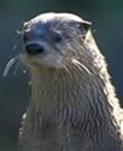You are here
Otters
 The Eurasian otter (Lutra lutra) is often difficult to census and in recent years it has become increasingly common to turn to genetic approaches in order to gain an accurate count of the numbers using a particular area. In particular, non-invasive methods such as those involving DNA extraction from otter spraint material, have been employed. Part of my PhD project is aimed at improving upon established techniques for using DNA extracted from spraint to census otter populations. The technique will be used to count and determine the genetic diversity of otter populations using the River Camel catchment in Cornwall and the River Itchen catchment in Hampshire.
The Eurasian otter (Lutra lutra) is often difficult to census and in recent years it has become increasingly common to turn to genetic approaches in order to gain an accurate count of the numbers using a particular area. In particular, non-invasive methods such as those involving DNA extraction from otter spraint material, have been employed. Part of my PhD project is aimed at improving upon established techniques for using DNA extracted from spraint to census otter populations. The technique will be used to count and determine the genetic diversity of otter populations using the River Camel catchment in Cornwall and the River Itchen catchment in Hampshire.
Otters are at the top of the UK aquatic food chain making them an ideal candidate species for studies of ecotoxicology. In particular, MEEG scientist Angela Pountney is interested in levels of polybrominated diphenyl ethers (PBDEs) in the livers of otters. PBDEs have been used in large quantities to flame retard many man made materials, including plastics, textiles, foams and polystyrenes. In recent years it has been recognised that many PBDE congeners are potential endocrine disruptors and as a result the majority of commercial PBDE mixtures have been banned from manufacture, sale and use within the European Union. Despite the recent halt in production the most widely used PBDE congeners are still commonly found in environmental and biological samples.
In a project run by the Environment Agency otter carcasses are collected and sent for post mortem at either the Wildlife Veterinary Investigation Centre (Wildlife VIC) in Cornwall or the Cardiff University Otter Project (CUOP) Laboratory. During post mortem liver tissue is, where appropriate, removed and stored frozen for further analysis. Under the supervision of Dr Gareth Thomas at the University of Lancaster, Angela is analysing a set of these livers for PBDE congener content.
- 26512 reads
The University of Exeter, The Queen's Drive, Exeter, Devon, UK EX4 4QJ
Copyright and Disclaimer

